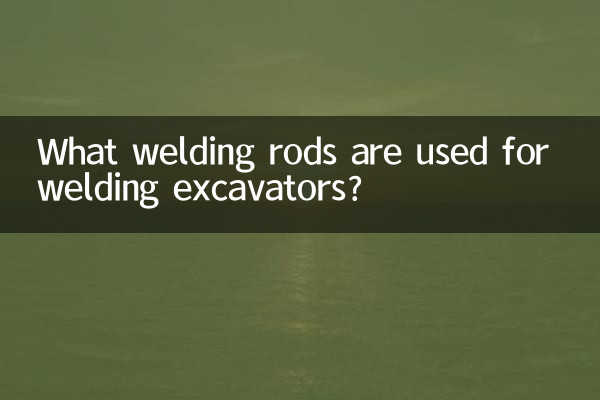What welding rods are used for welding excavators?
In the field of construction machinery maintenance and manufacturing, welding technology is a crucial link. As a high-intensity work equipment, the welding quality of excavators directly affects the service life and safety of the equipment. Choosing the right welding rod is the key to ensuring welding quality. This article will focus on the selection of welding rods for welding excavators, combined with hot topics and hot content in the past 10 days, to provide you with detailed structured data and analysis.
1. Commonly used types of welding rods for welding excavators

When welding an excavator, it is necessary to select the appropriate welding rod according to the base material material, welding location and working conditions. The following are common welding rod types and their characteristics:
| Welding rod type | Applicable materials | Features | Typical applications |
|---|---|---|---|
| J506 (E5016) | Low carbon steel, low alloy steel | Good crack resistance and high strength | Excavator boom and bucket tooth repair |
| J507(E5015) | Low carbon steel, low alloy steel | Low hydrogen type, low temperature resistant | Welding of high-strength parts |
| Surfacing electrode (such as D256) | High manganese steel | Strong wear resistance | Bucket teeth and blade repair |
| Stainless steel welding rod (such as A302) | stainless steel | Corrosion resistant | Parts for special conditions |
2. Things to note when choosing welding rods
1.Parent material match: The welding rod must match the chemical composition and mechanical properties of the excavator base material, otherwise it may easily lead to welding cracks or insufficient strength.
2.Welding environment: In low-temperature or high-humidity environments, low-hydrogen welding rods (such as J507) should be preferred to reduce the risk of hydrogen-induced cracking.
3.Process requirements: Different welding rods have different current, voltage and welding speed requirements, which need to be selected according to equipment conditions and operating level.
3. Hot topics in the past 10 days: New progress in welding rod technology
1.Environmentally friendly welding rod: With the improvement of environmental protection requirements, smoke-free and low-toxic welding rods have become a hot topic. For example, some new welding rods improve the work environment by reducing welding fumes.
2.Intelligent welding: The popularity of automatic welding robots has made the selection of welding rods pay more attention to process stability, and the demand for high-compatibility welding rods has increased.
3.Wear-resistant repair technology: High manganese steel cladding electrodes have attracted much attention in the repair of excavator bucket teeth due to their excellent wear resistance.
4. Welding skills for welding excavators
1.Preheating treatment: For thick plates or high carbon steel parts, preheating to 150-250℃ is required before welding to reduce internal stress.
2.Multi-layer multi-pass welding: Multi-layer and multi-pass welding should be used for large-thickness components to avoid excessive heat input caused by single-pass welding.
3.Post weld insulation: After welding is completed, cover the weld with insulation cotton and cool slowly to prevent cracks.
5. Frequently Asked Questions
| question | Answer |
|---|---|
| What welding rod is used to weld the excavator boom? | J506 or J507 is recommended, which has high strength and good crack resistance. |
| How to choose wear-resistant cladding electrodes? | Choose D256 (high manganese steel) or D707 (tungsten carbide) according to the degree of wear. |
| What should I do if cracks appear after welding? | Check whether the welding rod is dry and whether the preheating is sufficient. If necessary, use a low-hydrogen welding rod. |
6. Summary
When welding an excavator, the choice of welding rod directly affects the welding quality and equipment life. By matching base materials, paying attention to environmental conditions, and mastering welding techniques, welding results can be significantly improved. Recent environmentally friendly welding rods and intelligent welding technology have also brought new development directions to the industry. We hope that the structured data in this article can provide a practical reference for your welding work.

check the details

check the details